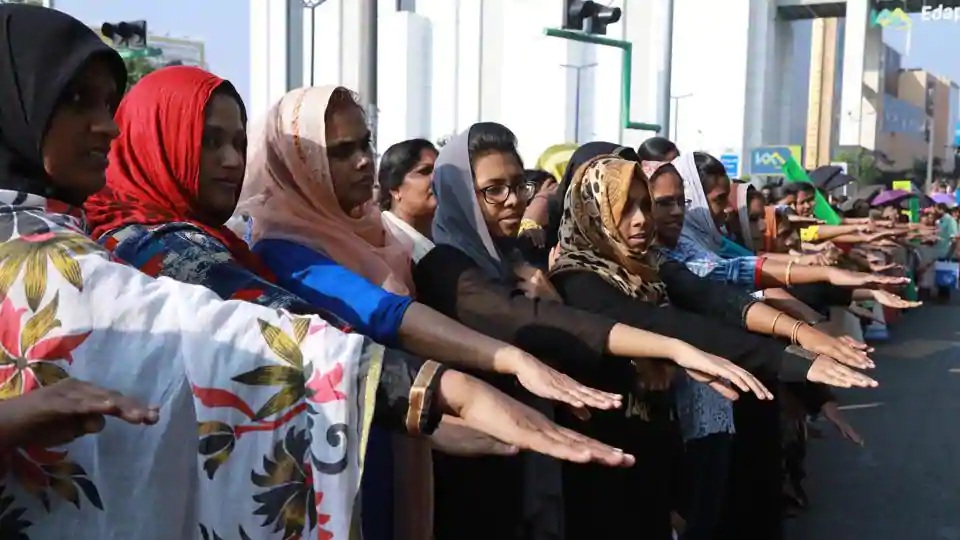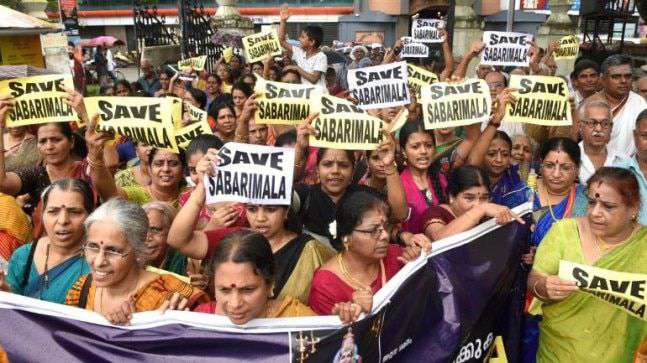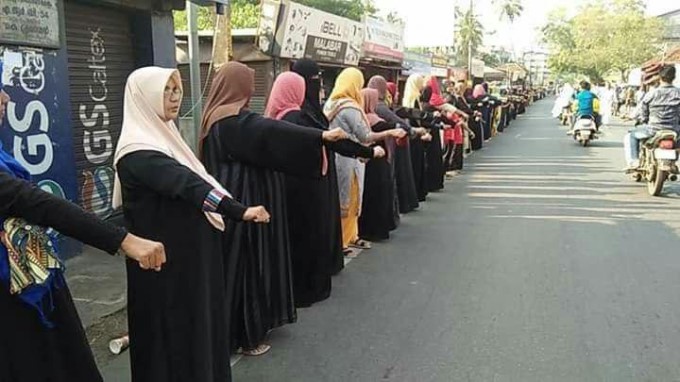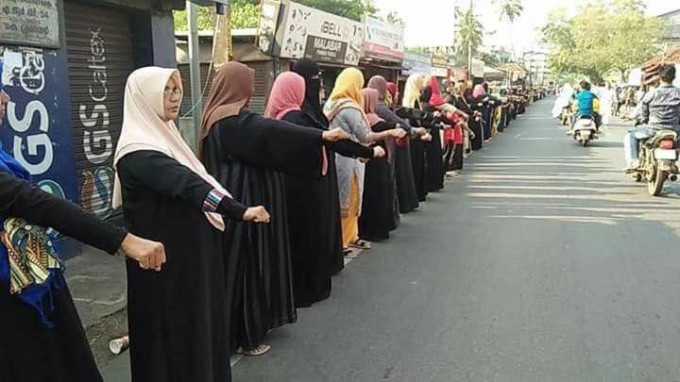
The unprecedented riots unleashed by the BJP and the Sangh Parivar organisations in Kerala on Thursday in their attempt to exploit the possible disquiet among some quarters of the Hindus following the entry of two women at the Sabarimala temple on Wednesday has resulted in a new political polarisation in the state: the BJP versus the CPM.
Completely lost out in the game by not taking either a socially progressive or constitutionally right position is the Congress, that too just ahead of the 2019 elections. In the process, the BJP has edged it out from its traditional antagonist role vis-a-vis the CPM. If the political equations get skewed further or even stay as they are, the Congress is going to be in trouble because on Sabarimala, it’s on the same side of the BJP.
What’s worse is that it even appears to be a clone of the BJP in a state where it’s known for its secular and renaissance values.

A protest opposing the entry of women into the Sabarimala temple
While it remains to be seen if the arson and riots that the state witnessed on Thursday will discourage the soft Hindu voters to throw their weight behind the BJP or it, they certainly show that the BJP and the Sangh organisations have been emboldened enough to take up the role of the main rival to the ruling CPM. Despite its best efforts, the CPM-led state government appeared meek in controlling the civil war-like situation wherein marauding protesters went about destroying public and private properties and waging wars with rival groups of people.
While Kerala’s civil society as a whole stood together against the violence, the Congress has yet again failed to take a stand that’s different from that of the BJP. The statements by all the leaders of the Congress in the state not only failed to slam the BJP and the Sangh for the violence, but they also echoed the latter’s effective position that faith and traditional practices are more important than what’s constitutionally right. While the BJP’s position was predictable given its ideology and eagerness to find an opportunistic communal breakthrough in the state, the Congress was unable to take a more nuanced position that was politically different from the CPM, but not similar to that of the BJP.
Although the core vote-bank of the United Democratic Front (UDF) that it leads comprises minorities such as the Muslims and Christians, the Congress’s problem is that it shares a major part of its political constituency with the BJP, namely the upper caste Hindus. In addition, it also lacks a cadre base. In the last Assembly elections, the BJP, along with its allies, had managed a vote share of 15 percent and wherever it gained strength, the Congress had been the loser. If the BJP further eats into the Congress vote base, the latter is going to be deeper in trouble. In the last elections, the rise of the BJP has either reduced the margin of the Congress candidates or has led to their defeat in many constituencies. In other words, the Congress is directly locked in a battle with the BJP as regards the upper caste Hindu votes.
Therefore, the Congress is evidently wary and doesn’t want to take a chance at all, even at the cost of appearing regressive. As a result, the party had to tragically take two contradicting positions — at the national level, it supports the entry of women into the temple on account of gender equality, while in the state, it opposes it because it hurts the religious sentiments of people. The reported intervention of Sonia Gandhi to dissuade the Congress MPs from staging a black-badge protest in Parliament against the entry of women to the temple was a clear manifestation of this contradiction. Unfortunately, the Congress’ plight has come to such a helpless pass that every time the Congress leaders in the state, whether it’s Opposition leader in the Assembly Ramesh Chennithala or the state unit president Mullappally Ramachandran, speak on the issue, they sound like the unreasonable BJP leaders.
The CPM, on the other hand, has taken a calculated risk although its principal vote bank is also Hindus, mostly the Ezhavas, the powerful backward caste that accounts for about 27 percent of the state’s population. The CPM’s strategy is to take the BJP head on for two reasons — one, it will win the support of the progressive and left-leaning civil society and also probably bring in the elusive minorities. Since the devotees of Ayyappa do not belong to the upper castes alone, and probably comprise a larger number of the backward castes, it’s indeed a gamble; but ideologically, the CPM showed more character.

Members of Ayyappa Dharma Samrakshana Samithi (Delhi and NCR) display placards and raise slogans during a protest over the Sabarimala issue, at Kerala House, in New Delhi
In fact, the reality was that it had no other way. If it had tried to legally circumvent the Supreme Court verdict allowing entry of women of all ages to Sabarimala, which triggered the whole controversy, or soft-pedalled its implementation, it would have appeared to be on the same side of the BJP. The CPM was very clear and resolute right from the beginning — it wouldn’t fall for the game of religious appeasement and would prefer to gain a moral upper hand. The “Wall of Women” it spearheaded on 1 January was a pilot to gauge the public mood and its success gave enough political thrust to the Pinarayi Vijayan government to take the risk of facilitating the entry of two women to the temple. Reportedly, in the coming days more women are likely to visit the shrine with the help of the police.

The CPM’s political calculation is also to weaken the Congress by pitting itself against the BJP. When the CPM projects the BJP as its main antagonist, Congress runs the risk of getting sidelined by the Hindu voters because they have a new political dispensation to back. The CPM probably assumes that even a marginal rise in the BJP’s vote share will be good enough to destroy the Congress’ chances, as it happened in other states.
However, what’s completely unknown is if the backward caste Hindu votes also will be influenced by these developments, because such faith-based political polarisation has never been tested in the state. Probably, that would be the only hope for the Congress — to retain the upper caste Hindu votes by taking a stand similar to that of the BJP, and expect a defection of backward caste Hindu votes of the CPM towards itself.
For the BJP, it’s pretty simple, because communal polarisation is its only weapon to gain some foothold in the state, while for the CPM and the Congress, the strategy is to weaken each others’ constituencies. The CPM has taken a radical approach, while the Congress has tried to play if safe. Which one will pay off? One has to wait till 2019 elections.




